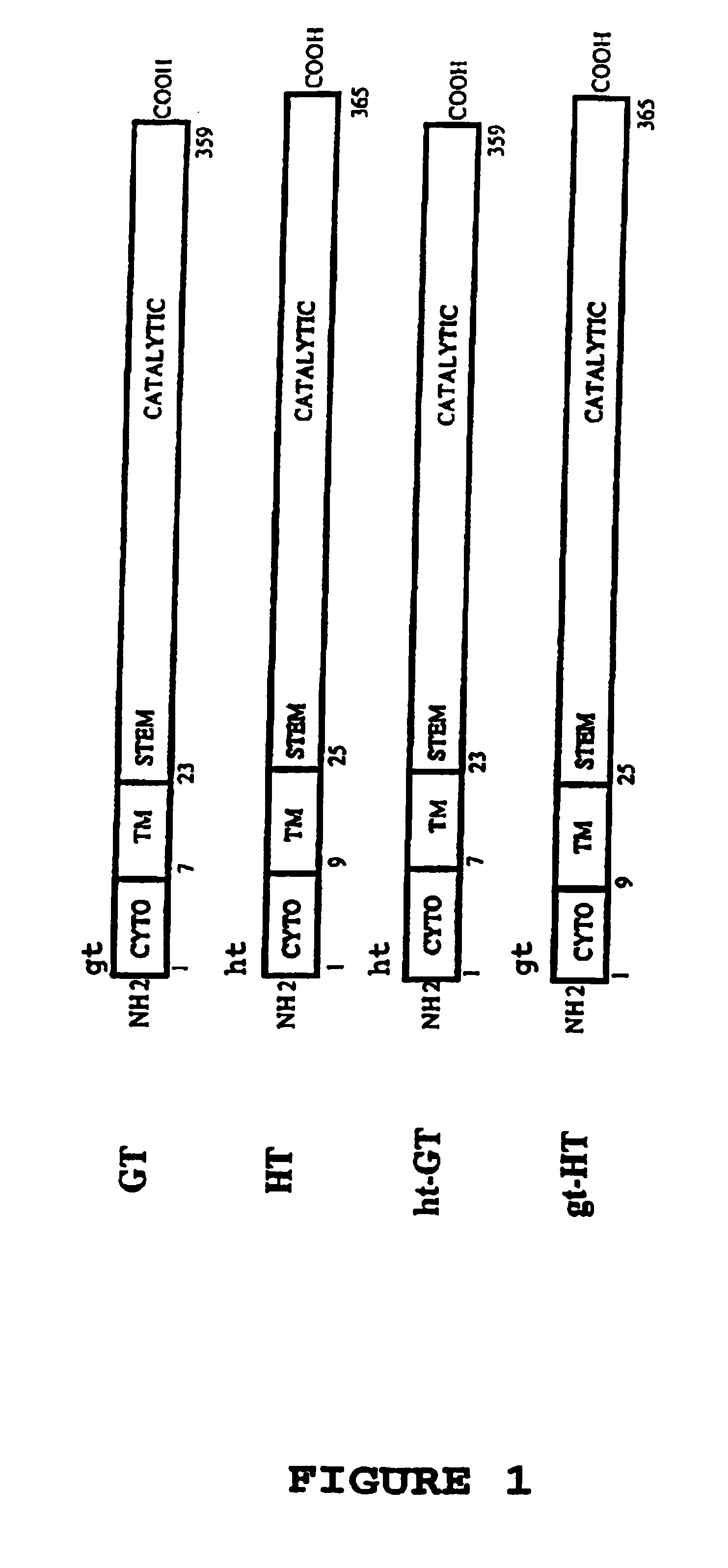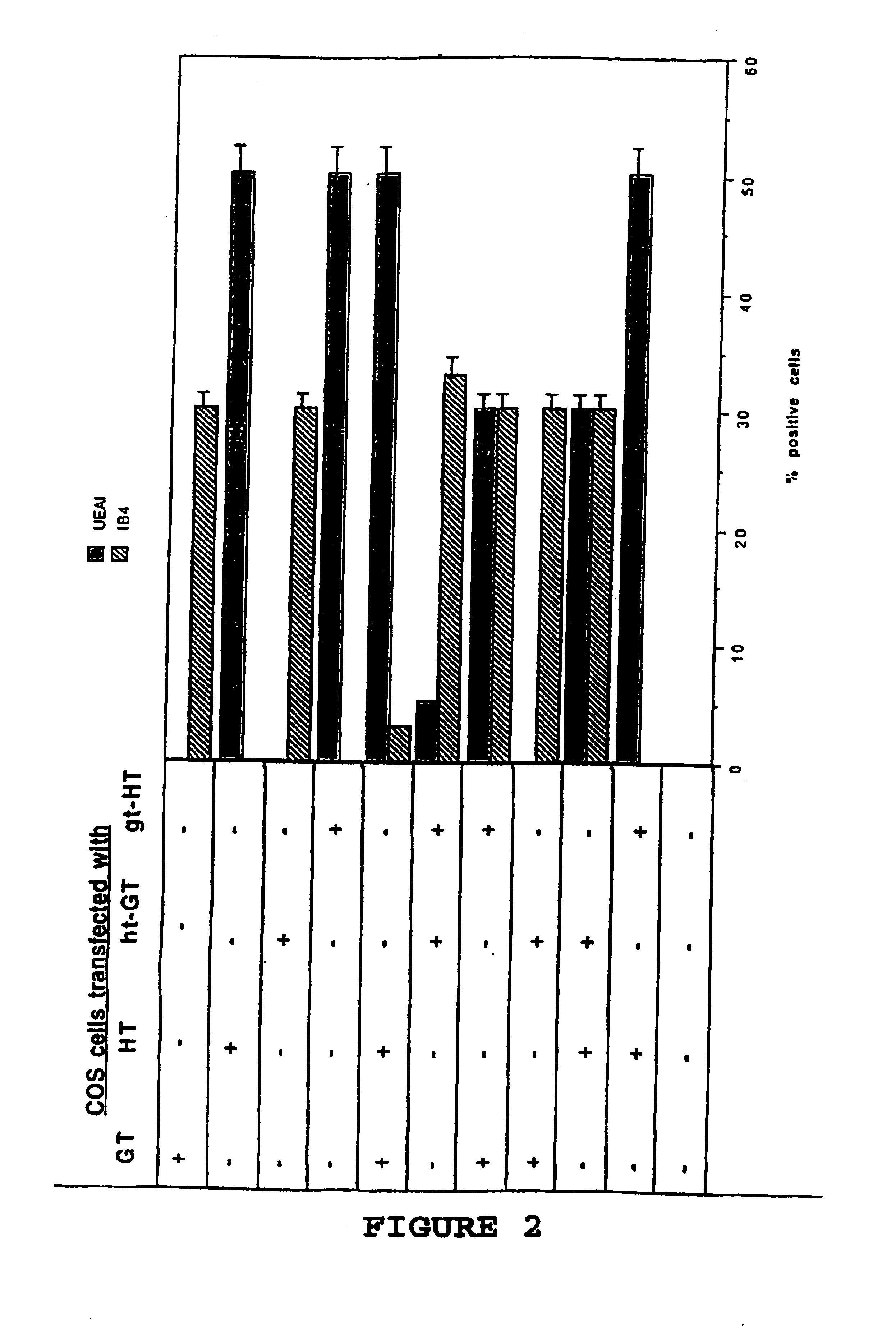Nucleic acids encoding a chimeric glycosyltransferase
a glycosyltransferase and nucleic acid technology, applied in the field of nucleic acids, can solve the problems of affecting the quality of human organs, so as to reduce the level of undesirable epitopes
- Summary
- Abstract
- Description
- Claims
- Application Information
AI Technical Summary
Benefits of technology
Problems solved by technology
Method used
Image
Examples
example 1
[0068]Plasmids—The plasmids used were prepared using standard techniques (7); pGT encodes the cDNA for the porcine α(1,3)galactosyltransferase (23), pHT encodes the cDNA for the α(1,2)fucosyltransferase (human) (25). Chimeric glycosyltransferase cDNAs were generated by polymerase chain reaction as follows: an 1105 bp product ht-GT was generated using primers corresponding to the 5′ end of ht-GT (5′-GCGGATCCATGTGGCTCCGGAGCC ATCGTCAGGTGGTTCTGTCAATGC TGCTTG-3′) (SEQ ID NO. 5) coding for nucleotides 1-24 of HT (25) followed immediately by nucleotides 68-89 of GT (8) and containing a BamH1 site (underlined) and a primer corresponding to the 3′ end of ht-GT (5′-GCTCTAGAGCGTCAGATGTTATT TCTAACCAAATTATAC-3′) (SEQ ID NO. 6) containing complementarity to nucleotides 1102-1127 of GT with an Xbal site downstream of the translational stop site (underlined); an 1110 bp product gt-HT was generated using primers corresponding to the 5′ end of gt-HT (5′-GCGGATCCATGAATGTCAAAGGAAGACTCTGCCTGGCCT TCCTGC-...
example 2
[0082]Use of Secretor in Construction of a Chimeric Enzyme
[0083]A construct is made using PCR and subcloning as described in Example 1, such that amino acids #1 to #6 of the pig α(1,3)-galactosyltransferase (MNVKGR) (SEQ ID NO: 14) replace amino acids #1 to #5 of the pig secretor (FIG. 6). Constructs are tested as described in Example 1.
example 3
[0084]Use of Pig H Transferase in Construction of a Chimeric Enzyme
[0085]A construct is made using PCR and subcloning as described in Example 1, such that amino acids #1 to #6 of the pig α(1,3)-galactosyltransferase (MNVKGR) (SEQ ID NO. 14) replace amino acids #1 to 8 of the pig H transferase (FIG. 7). Constructs are tested as described in Example 1.
PUM
 Login to View More
Login to View More Abstract
Description
Claims
Application Information
 Login to View More
Login to View More - R&D
- Intellectual Property
- Life Sciences
- Materials
- Tech Scout
- Unparalleled Data Quality
- Higher Quality Content
- 60% Fewer Hallucinations
Browse by: Latest US Patents, China's latest patents, Technical Efficacy Thesaurus, Application Domain, Technology Topic, Popular Technical Reports.
© 2025 PatSnap. All rights reserved.Legal|Privacy policy|Modern Slavery Act Transparency Statement|Sitemap|About US| Contact US: help@patsnap.com



